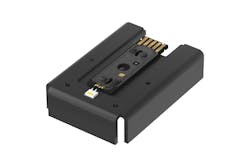Osram Continental plans to bring LED technology to every headlamp
The Osram Continental joint venture focused on automotive lighting recently hosted a webcast for customers and some media to reveal a new modular light engine — the eXchangeable Light Engine (XLE) — for automotive headlamps. The focus of the event was solid-state lighting (SSL) in every vehicle from the lowest-cost vehicle in a fleet to the top of the line. The technology looks promising. But the joint venture has not provided a future roadmap for deployment and sales, and presumably remains on a path to disband the joint venture later this year.
Osram and Continental announced the joint venture back in the summer of 2018. Of course we didn’t foresee the future in 2018, but Osram was poised to go through an incredibly rocky time and ultimately the acquisition by ams. We have a story just posted on the latest on the Osram and ams saga. Presumably, the automotive market remains a primary interest for Osram. But Osram and Continental separately announced last September that the 50:50 joint venture would be disbanded by fall 2021.
Indeed, the business side of the story seems to dominate the technology story relative to the XLE modules. We asked which company would sell and support the platform or if both would. We have not received a response. When the duo announced they would disband the joint venture, they did state they would maintain a close partnership. Still, we’d expect more details on the future supply chain.
The speakers at the webcast did not state that the LEDs used in the new modules were from Osram Opto Semiconductors. We would presume they are. There are a few words in the press release that hint at perhaps the XLE becoming an industry standard. Now that could mean that Osram Continental expects the modules to simply dominate the market. Or it could mean the duo may allow other industry players to replicate it.
The modules have a small rectangular form (seen above). The open-frame housing acts as a heat sink. The LEDs are mounted and connected to a simple printed-circuit board (PCB) that integrates a card-edge connector at the opposite end from the LEDs. At launch there are three versions — one with two emitters and two with three emitters.
The modules were designed to work with standardized reflector cavities with the light engine radiating from a mounting location at the top of the cavity. The automotive designer will have flexibility to use two, three, or four reflector cavities to enable flexibility in style and function.
The three variants measure 40×58×13, 45×65×17, and 55×75×17 mm. The XLE 650 delivers 720 lm, the XLE 900 delivers 970 lm, and the XLE 1100 delivers 1160 lm. The companies further said that they will deliver LED driver technology to mate with the modular light engines.
The webcast presenters said the module family and standardized reflectors could deliver everything required in a modern LED headlamp such as multiple beams, daytime running lights (DRLs), and more. Moreover, auto designers would have some ability to add more advanced features, although these XLE modules are not intended for applications such as adaptive drive beam headlamps. Osram has been at the forefront of adaptive technologies. The company showed a prototype module a couple of years back with 1024 individually-controllable pixels and integrated driver technology.
Back to the XLE, Osram Continental did show a supply chain timeframe for the new modules. Samples are available now. The companies said they would enter that Production Part Approval Process (PPAP) in January 2022. The XLE project has moved rapidly for the automotive industry. The companies said the project started in June 2020.
The XLE technology could remove the cost barrier to broader LED usage in headlamps. The presenters used Ford as an example, saying the technology could serve “the Focus to the F150 pickup.” Target customers will be Tier 1 and 2 suppliers to the auto industry and also the OEM brands themselves.
LEDs Magazine chief editor MAURY WRIGHT is an electronics engineer turned technology journalist, who has focused specifically on the LED & Lighting industry for the past decade.
For up-to-the-minute LED and SSL updates, why not follow us on Twitter? You’ll find curated content and commentary, as well as information on industry events, webcasts, and surveys on our LinkedIn Company Page and our Facebook page.

Maury Wright | Editor in Chief
Maury Wright is an electronics engineer turned technology journalist, who has focused specifically on the LED & Lighting industry for the past decade. Wright first wrote for LEDs Magazine as a contractor in 2010, and took over as Editor-in-Chief in 2012. He has broad experience in technology areas ranging from microprocessors to digital media to wireless networks that he gained over 30 years in the trade press. Wright has experience running global editorial operations, such as during his tenure as worldwide editorial director of EDN Magazine, and has been instrumental in launching publication websites going back to the earliest days of the Internet. Wright has won numerous industry awards, including multiple ASBPE national awards for B2B journalism excellence, and has received finalist recognition for LEDs Magazine in the FOLIO Eddie Awards. He received a BS in electrical engineering from Auburn University.





